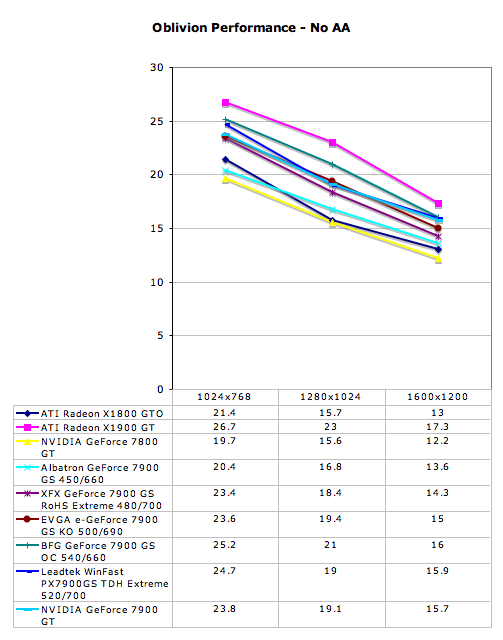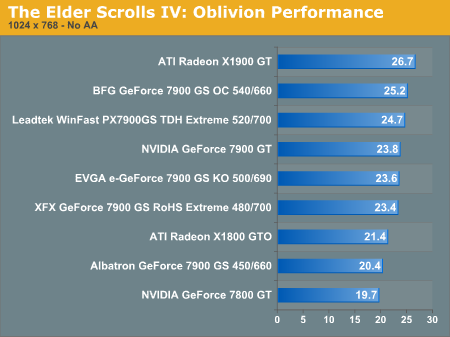The NVIDIA GeForce 7900 GS: A Closer Look
by Josh Venning on September 19, 2006 5:00 AM EST- Posted in
- GPUs
The Elder Scrolls IV: Oblivion
Our third and final benchmark is from The Elder Scrolls IV: Oblivion. This is a fairly recent game which boasts some of the most advanced graphics of any game available to date. Oblivion is one of the most beautiful games we've ever played, and unfortunately it is also one of the most graphically demanding. It can easily put a huge strain on most graphics cards when quality settings are turned up.
We mentioned recently in our silent GPU review that we don't recommend playing Oblivion on a budget or low/midrange graphics card, and we stand by this statement. The game loses a lot of playability without things like Distand Land turned on. This is why we test the game with higher quality settings enabled. Here are the quality settings we used for these test.


For this benchmark, we use FRAPS to measure the average FPS while walking towards an Oblivion gate at night. The margin of error is about 5% for each card, so smaller differences can be ignored. This is one of the more graphically intensive benchmarks we have for this game, and that's why we see such low framerates across the board, even among the faster cards.
This is a game where having a higher clocked 7900 GS is really ideal over a lower clocked one like the Albatron 7900 GS. With a framerate of 25.2 FPS at 1024x768 (which is a very playable resolution for this game), the BFG 7900 GS OC offers much better performance than the 20.4 FPS we see from the Albatron 7900 GS. Considering this, we would recommend either the overclocked BFG or Leadtek 7900 GS to anyone interested in a 7900 GS for playing Oblivion.
Also, because this game tends to favor ATI hardware over NVIDIA, we see that this is one case where the X1900 GT beats out all of the 7900 GS cards in performance in spite of their factory overclocks. If Oblivion is your game of choice and you are looking for a graphics upgrade at around the $200 range, the Connect3D Radeon X1900 GT is available at the time of this writing for $220 and is a good option.
Our third and final benchmark is from The Elder Scrolls IV: Oblivion. This is a fairly recent game which boasts some of the most advanced graphics of any game available to date. Oblivion is one of the most beautiful games we've ever played, and unfortunately it is also one of the most graphically demanding. It can easily put a huge strain on most graphics cards when quality settings are turned up.
We mentioned recently in our silent GPU review that we don't recommend playing Oblivion on a budget or low/midrange graphics card, and we stand by this statement. The game loses a lot of playability without things like Distand Land turned on. This is why we test the game with higher quality settings enabled. Here are the quality settings we used for these test.
| Oblivion Performance Settings | |
| Texture Size | Large |
| Tree Fade | 100% |
| Actor Fade | 100% |
| Item Fade | 66% |
| Object Fade | 90% |
| Grass Distance | 50% |
| View Distance | 100% |
| Distant Land | On |
| Distant Buildings | On |
| Distant Trees | On |
| Interior Shadows | 95% |
| Exterior Shadows | 85% |
| Self Shadows | On |
| Shadows on Grass | On |
| Tree Canopy Shadows | On |
| Shadow Filtering | High |
| Specular Distance | 100% |
| HDR Lighting | On |
| Bloom Lighting | Off |
| Water Detail | High |
| Water Reflections | On |
| Water Ripples | On |
| Window Reflections | On |
| Blood Decals | High |
| Anti-aliasing | Off |


For this benchmark, we use FRAPS to measure the average FPS while walking towards an Oblivion gate at night. The margin of error is about 5% for each card, so smaller differences can be ignored. This is one of the more graphically intensive benchmarks we have for this game, and that's why we see such low framerates across the board, even among the faster cards.
This is a game where having a higher clocked 7900 GS is really ideal over a lower clocked one like the Albatron 7900 GS. With a framerate of 25.2 FPS at 1024x768 (which is a very playable resolution for this game), the BFG 7900 GS OC offers much better performance than the 20.4 FPS we see from the Albatron 7900 GS. Considering this, we would recommend either the overclocked BFG or Leadtek 7900 GS to anyone interested in a 7900 GS for playing Oblivion.
Also, because this game tends to favor ATI hardware over NVIDIA, we see that this is one case where the X1900 GT beats out all of the 7900 GS cards in performance in spite of their factory overclocks. If Oblivion is your game of choice and you are looking for a graphics upgrade at around the $200 range, the Connect3D Radeon X1900 GT is available at the time of this writing for $220 and is a good option.










42 Comments
View All Comments
sum1 - Friday, September 22, 2006 - link
It’s listed at 540MHz everywhere else in this article (including the benchmarks).I posted this discrepancy twice, days ago, hasn’t anyone else noticed yet?
Josh Venning - Saturday, September 23, 2006 - link
It's been fixed. Thanks for pointing this out, and we apologize for not fixing it sooner.PerfectCr - Thursday, September 21, 2006 - link
Fan Noise? How do I know how loud/quiet the fans are? Do they throttle?kmmatney - Tuesday, September 19, 2006 - link
Its interesting how the XFX card (the only RoHS card - uses less lead and other hazardous chemicals) uses more power. I wonder if this will be true of other RoHS devices.yyrkoon - Wednesday, September 20, 2006 - link
I can tell you that the motherbord I use, which is also RoHS 'certified' (Asrock AM2NF4G-SATA2) runs pretty dahmed cool (sub 95F, when ambient is 80F ish), doesnt even use active cooling for the chipset etc either. Reguardless, if its the actual cause or not, I think its well worth it in the long run.Zaitsev - Tuesday, September 19, 2006 - link
On page 3 third line, "NVIDIDA intends for it to be a direct competitor to ATI's X1900 GT"Zaitsev - Tuesday, September 19, 2006 - link
Sorry, that should be page 2.Josh Venning - Tuesday, September 19, 2006 - link
fixed, thanksHoward - Tuesday, September 19, 2006 - link
I believe the bar is there to reduce PCB bending under weight.DerekWilson - Tuesday, September 19, 2006 - link
It's possible I suppose ... but it seems to me that you'd want to attatch the bar to the pcb at more than two points if this is the case. And you might also want to connect it to the slot cover for the added support of the case screw. Granted, I'm not a mechanical engineer, but it seems to me that connecting one part of the pcb to another like this would just move any moment created by the weight of the HSF somewhere else on the pcb.I've also never seen a graphics board bend under normal use. Intel motherboards are another story though. :-)
Whether or not its made for this, I do have a good use for it: having this bar makes it easier to find a place to grab when removing the card. Sometimes it's tough to find a spot on the pcb to grab, and sometimes the HSF solution isn't mounted in such a way that it's stable enough to use either (I distinctly remember the 6600 GT really disliking any contact with the HSF). This doesn't apply to the huge heat-sink-is-bigger-than-my-forearm solutions though -- they're usually bolted on pretty tight.